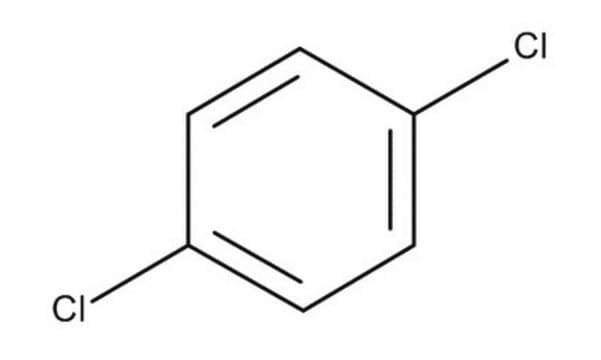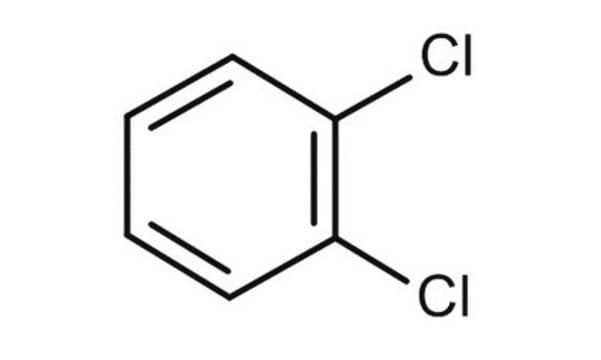D56829
1,4-Dichlorobenzene
≥99%
Synonym(s):
1,4-Dichlorobenzene, Di-chloricide, Dichlorocide, PDB, Paradichlorobenzene, p-Chlorophenyl chloride, p-Dichlorobenzene, para-Dichlorobenzene
About This Item
Recommended Products
vapor density
5.07 (vs air)
Quality Level
vapor pressure
1.03 mmHg ( 25 °C)
Assay
≥99%
form
crystalline solid
bp
173 °C (lit.)
mp
52-54 °C (lit.)
density
1.241 g/mL at 25 °C (lit.)
SMILES string
Clc1ccc(Cl)cc1
InChI
1S/C6H4Cl2/c7-5-1-2-6(8)4-3-5/h1-4H
InChI key
OCJBOOLMMGQPQU-UHFFFAOYSA-N
Gene Information
human ... CYP2A6(1548)
mouse ... Cyp2a5(13087)
Looking for similar products? Visit Product Comparison Guide
Related Categories
Application
- In the synthesis of nitro-aromatics via electrophilic nitration.
- To synthesize polyarylbenzenes through C-C cross coupling with arylboronic acids using imidazolium salt as a catalyst.
- In the Pd-catalyzed Mizoroki-Heck coupling reaction with alkenes.
Signal Word
Warning
Hazard Statements
Precautionary Statements
Hazard Classifications
Aquatic Acute 1 - Aquatic Chronic 1 - Carc. 2 - Eye Irrit. 2
Storage Class Code
11 - Combustible Solids
WGK
WGK 2
Flash Point(F)
Not applicable
Flash Point(C)
Not applicable
Personal Protective Equipment
Regulatory Listings
Regulatory Listings are mainly provided for chemical products. Only limited information can be provided here for non-chemical products. No entry means none of the components are listed. It is the user’s obligation to ensure the safe and legal use of the product.
PRTR
Class I Designated Chemical Substances
ISHL Indicated Name
Substances Subject to be Indicated Names
ISHL Notified Names
Substances Subject to be Notified Names
JAN Code
D56829-VAR:
D56829-BULK:
D56829-3KG:4548173956114
D56829-100G:4548173956107
D56829-25G:
D56829-5G:4548173956121
D56829-500G:
Choose from one of the most recent versions:
Already Own This Product?
Find documentation for the products that you have recently purchased in the Document Library.
Customers Also Viewed
Our team of scientists has experience in all areas of research including Life Science, Material Science, Chemical Synthesis, Chromatography, Analytical and many others.
Contact Technical Service












